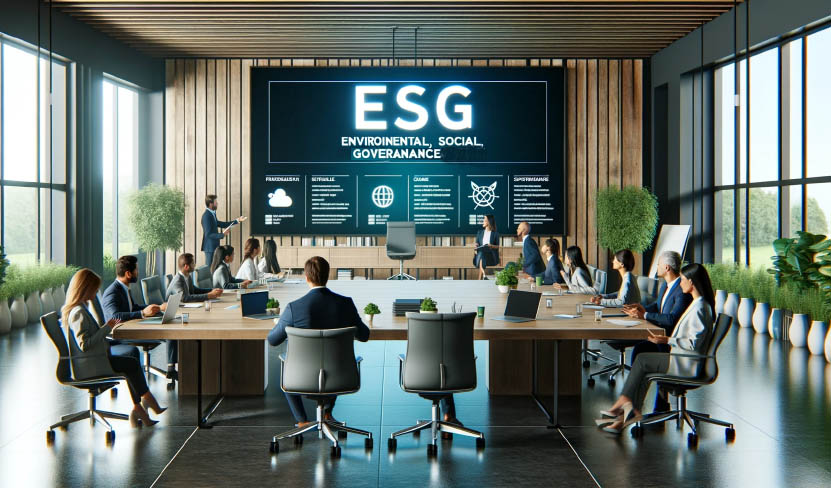In today’s world, it is essential to align your organization’s values and mission with Environmental, Social, and Governance (ESG) criteria to ensure sustainability! This is especially crucial in the fashion industry, where sustainable practices are under increasing scrutiny.
CEOs and sustainability consultants in the fashion industry must understand and integrate ESG criteria! This is not just about compliance or public image, but about pioneering a future where business success and environmental stewardship go hand in hand. It involves building a brand that resonates with the values of a new generation of consumers and investors, who increasingly make choices based on a company’s ethical and environmental footprint.
This blog post is an exciting and confident guide for fashion industry leaders who want to integrate ESG criteria into their organization’s strategy and operations! It offers practical steps and strategies to embed ESG criteria into the core of your organization. The goal is to achieve sustainable transformation, which will not only increase profitability but also create a positive impact.
1. Define Your Vision, Mission and Goals
To align your organization with ESG criteria, it is crucial to define your vision, mission and goals. This step is not just about setting targets; it’s about envisioning a future where your fashion company not only thrives in the market but also champions sustainable and ethical practices. Envisioning a Sustainable Future!
Imagine a future where your brand is synonymous with sustainability. This vision should encompass not just environmental stewardship but also social responsibility and robust governance. It’s a future where your products are not only fashionable but also ethically produced, where your operations minimize environmental impact, and where your governance structures uphold transparency and integrity. This vision should resonate with your brand’s identity, aligning seamlessly with the values that your company stands for.
Once your vision is clear, it’s time to translate it into tangible goals. These goals should be ambitious yet achievable, pushing your organization to new heights of sustainability while remaining grounded in reality. Think about what you want to achieve in the next year, five years, or even a decade. Do you want to reduce your carbon footprint by a specific percentage? Or perhaps ensure complete supply chain transparency?
Goals drive Change
These goals should serve as beacons, guiding your company’s decisions and strategies. They are not just milestones but also commitments to your stakeholders, from your employees and customers to the wider community and the environment. Remember, your goals are not just about compliance or meeting industry benchmarks. They are reflections of your organization’s aspirations and commitments to a better, more sustainable world. By defining clear, impactful goals, you set the stage for meaningful change, paving the way for a fashion industry that is as responsible as it is vibrant.
- Long-term Perspective: Develop a vision that goes beyond immediate gains, focusing on long-term sustainability and ethical practices.
- Alignment with Core Values: Ensure your sustainability vision is in harmony with the core values of your organization. This creates a cohesive approach to business and sustainability.
Setting SMART ESG Goals
From these long-term goals, it is important to formulate short-term, so-called SMART (specific, measurable, achievable, relevant, and time-bound) goals that are in line with your vision and the ESG criteria that are most important to your company.
- Specific: Define clear, precise goals. For instance, reducing carbon emissions by a certain percentage or achieving a diverse workforce.
- Measurable: Establish metrics and KPIs to track progress. This might include annual sustainability reports or ESG scorecards.
- Achievable: Set realistic goals that challenge your organization but are attainable.
- Relevant: Ensure goals are pertinent to your business and the wider fashion industry.
- Time-bound: Set deadlines to achieve these goals, fostering a sense of urgency and focus.
2. Develop Your Strategy and Action Plan
After setting your vision, you mission and goals, it’s time to craft a strategy and action plan that will turn these aspirations into reality. This phase is about bridging the gap between where you are and where you want to be in terms of ESG performance.
Crafting a Holistic Strategy
Developing a comprehensive ESG strategy requires a holistic view of your organization. It’s about integrating sustainable practices into every aspect of your business, from supply chain management to product design, marketing, and governance. This strategy should be a reflection of your company’s commitment to sustainability, not just a set of isolated initiatives.
Consider how your products and services impact the environment and society. Can materials be more sustainable? How can you ensure fair labor practices across your supply chain? These questions are integral to forming a strategy that is both ethical and practical.
Building an Actionable Plan
An actionable plan is the blueprint of your strategy. It outlines the specific steps your organization will take to achieve its ESG goals. This plan should be clear, detailed, and aligned with your business operations. It’s important to assign responsibilities and establish timelines for each action to ensure accountability and progress.
Engage with different departments within your organization to make sure that the plan is feasible and that everyone is on board. This collaboration fosters a shared sense of purpose and commitment to the ESG goals. Remember, a successful strategy and action plan are not set in stone. They should be flexible enough to adapt to new insights, market trends, and regulatory changes. Regular reviews and updates will keep your strategy relevant and effective.
Through this process, your organization will not only advance in its ESG goals but also become a leader in sustainable practices within the fashion industry, setting a benchmark for others to follow.
3. Communicate and Engage Your Stakeholders
An integral part of embedding ESG criteria into your organization is effectively communicating and engaging with your stakeholders. This step goes beyond mere dissemination of information; it’s about fostering an inclusive dialogue where stakeholders feel heard, valued, and involved in your sustainability journey.
Creating a Dialogue for Change
Transparency is key in stakeholder communication. Share your sustainability goals, the progress made, and the challenges encountered. This openness not only builds trust but also encourages feedback and ideas, creating a rich pool of perspectives that can enhance your ESG initiatives.
Consider using various communication channels to reach different stakeholders. For instance, social media and newsletters can keep customers and the public informed, while dedicated platforms or meetings can engage employees and investors more deeply.
Involving Stakeholders in the Process
Stakeholder engagement is not a one-way street. It’s about creating opportunities for stakeholders to contribute to your sustainability efforts. This could include customer surveys to understand their sustainability preferences or workshops with employees to co-create greener workplace practices.
Such engagement not only garners valuable insights but also strengthens the commitment of stakeholders to your brand. When people see their ideas being implemented or their concerns addressed, it fosters a sense of ownership and loyalty.
Remember, every stakeholder interaction is an opportunity to reinforce your commitment to sustainability and to cultivate advocates for your brand’s ESG efforts.
4. Monitor and Evaluate Your Progress
The journey towards integrating ESG criteria into your organization is ongoing. Monitoring and evaluating your progress is essential to understand the impact of your actions and to make informed decisions for future strategies.
Embracing a Data-Driven Approach
Adopting a data-driven approach is key in this phase. Regularly collecting and analyzing data related to your ESG goals allows you to track your performance accurately. This might include measuring your carbon footprint, assessing the diversity of your workforce, or evaluating the ethical sourcing of your materials.
Leveraging technology for data analysis can provide deeper insights into your sustainability efforts. Tools and software designed for ESG reporting can help in deciphering complex data and presenting it in an understandable format, enabling your team to identify trends, successes, and areas needing improvement.
You can use indicators, metrics, and tools, such as the Global Reporting Initiative (GRI), the Sustainability Accounting Standards Board (SASB), or the ESG Scorecard, to monitor and evaluate your progress. You can also use audits, surveys, and interviews to collect qualitative and quantitative data and insights.
Feedback Loops and Continuous Improvement
Evaluation is not just about measuring success; it’s also about learning from your experiences. Establish feedback loops within your organization and with external stakeholders to gather diverse perspectives on your ESG initiatives.
This feedback, coupled with data insights, should inform your ongoing strategy. It’s an opportunity to refine your approach, experiment with new ideas, and continually enhance your sustainability efforts. Remember, the goal is not just to meet ESG criteria but to exceed them, pushing your organization towards new heights of sustainability and responsibility.
5. Learn and Improve Continuously
In the dynamic world of fashion, sustainability is not a destination but a continuous journey. Embracing an ethos of perpetual learning and improvement is essential to stay ahead in the ever-evolving landscape of ESG criteria.
Fostering a Culture of Innovation
Innovation is the heartbeat of the fashion industry, and this extends to sustainability practices. Encourage a culture where new ideas are welcomed and explored. Whether it’s experimenting with eco-friendly materials, adopting new manufacturing processes, or exploring innovative recycling programs, each step is a leap towards a more sustainable future.
Regular training and workshops can keep your team updated on the latest sustainability trends and techniques. Collaborations with external experts and institutions can bring fresh perspectives and expertise to your sustainability initiatives.
Adapting to Changing Norms
The benchmarks for sustainability are constantly shifting as new challenges emerge and technologies evolve. Staying adaptable and responsive to these changes is crucial. This means regularly reviewing and updating your ESG strategy to align with current best practices and regulations.
Measuring Long-term Impact
While immediate results are important, sustainability is about creating lasting change. Measure the long-term impact of your initiatives on the environment, your employees, and the community. This long-term perspective not only ensures sustainable growth but also cements your brand’s legacy as a leader in sustainable fashion.
By committing to continuous learning and improvement, your organization not only contributes to a more sustainable world but also inspires others in the industry to follow suit. It’s a journey that goes beyond compliance, towards building a brand that stands for responsibility, innovation, and ethical elegance.
Summary and overview of the individual steps in the integration of ESG criteria in fashion companies.
Step 1: Assess Your Current Situation
- Discuss the importance of understanding where your organization currently stands in terms of ESG criteria.
- Suggest methods for conducting a materiality assessment and identifying gaps.
Step 2: Define Your Vision, Mission and Goals
- Elaborate on setting SMART goals for ESG criteria alignment.
- Discuss the importance of integrating these goals with the overall corporate strategy.
Step 3: Develop Your Strategy and Action Plan
- Offer insights on integrating ESG criteria into the company’s operational and strategic plans.
- Suggest ways to incorporate CSR initiatives with ESG goals.
Step 4: Communicate and Engage Your Stakeholders
- Explain the importance of transparent communication with stakeholders.
- Discuss strategies for engaging different stakeholder groups, including employees, investors, and customers.
Step 5: Monitor and Evaluate Your Progress
- Provide methods for tracking and reporting on ESG-related metrics and KPIs.
- Discuss the importance of regular review and adaptation of ESG strategies.
Step 6: Learn and Improve Continuously
- Emphasize the need for ongoing learning and improvement in ESG practices.
- Suggest ways to stay informed about evolving ESG standards and practices.

